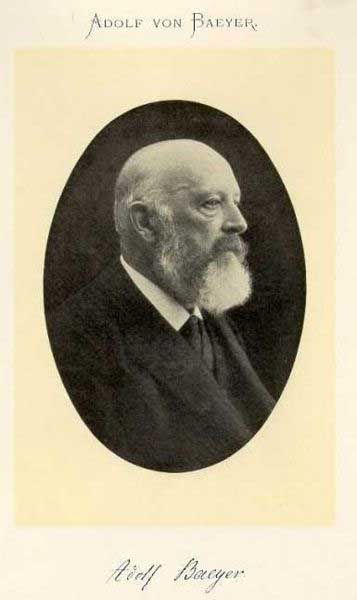
|
Johann Friedrich Wilhelm Adolf von Baeyer, 1905
Johann Friedrich Wilhelm Adolf von Baeyer (IPA: [ˈbaɪɐ]; October 31, 1835 - August 20, 1917) was a German chemist who synthesized indigo,[1]} and was the 1905 recipient of the Nobel Prize in Chemistry.[2] Born in Berlin, he initially studied mathematics and physics at Berlin University before moving to Heidelberg to study chemistry with Robert Bunsen. There he worked primarily in August Kekulé's laboratory, earning his doctorate (from Berlin) in 1858. He followed Kekulé to the University of Ghent, when Kekulé became professor there. He became a lecturer at the Berlin Trade Academy in 1860, and a Professor at the University of Strassburg in 1871. In 1875 he succeeded Justus von Liebig as Chemistry Professor at the University of Munich. Baeyer's chief achievements include the synthesis and description of the plant dye indigo, the discovery of the phthalein dyes, and the investigation of polyacetylenes, oxonium salts, nitroso compounds (1869) and uric acid derivatives (1860 and onwards) (including the discovery of barbituric acid (1864), the parent compound of the barbiturates). He was the first to propose the correct formula for indole in 1869, after publishing the first synthesis three years earlier. His contributions to theoretical chemistry include the 'strain' (Spannung) theory of triple bonds and strain theory in small carbon rings.[3] In 1872 he experimented with phenol and formaldehyde, almost preempting Leo Baekeland's later discovery of Bakelite. In 1881 the Royal Society of London awarded Baeyer the Davy Medal for his work with indigo. In 1905 he was awarded the Nobel Prize in Chemistry "in recognition of his services in the advancement of organic chemistry and the chemical industry, through his work on organic dyes and hydroaromatic compounds". Baeyer's name is pronounced like the English word "buyer." His birth name was Johann Friedrich Wilhelm Adolf Baeyer, but throughout most of his life he was known simply as "Adolf Baeyer." On his fiftieth birthday he was raised to the hereditary nobility, changing his name to "Adolf von Baeyer." References Footnotes 1. ^ Adolf Baeyer, Viggo Drewsen (1882). "Darstellung von Indigblau aus Orthonitrobenzaldehyd (p )". Berichte der deutschen chemischen Gesellschaft 15 (2): 2856-2864. doi:10.1002/cber.188201502274. 2. ^ Adolf von Baeyer: Winner of the Nobel Prize for Chemistry 1905 Armin de Meijere Angewandte Chemie International Edition Volume 44, Issue 48 , Pages 7836 - 7840 2005 Abstract 3. ^ Adolf Baeyer (1885). "Ueber Polyacetylenverbindungen". Berichte der deutschen chemischen Gesellschaft 18 (2): 294-295. doi:10.1002/cber.18850180296. General references * I. Asimov, Asimov's Biographical Encyclopedia of Science and Technology (2nd Ed.), Doubleday, 1982, p. 472 * J. R. Partington, A History of Chemistry, Macmillan, 1964, vol. 4, pp. 775-788 * A Biographical Dictionary of Scientists, Williams, T. I., Ed., Wiley, 1969, pp. 27-28 * Gienapp, Ruth Ann. "Baeyer, Adolph Johann Friedrich Wilhelm von." Dictionary of Scientific Biography, Charles Scribner's Sons, 1970-1990, vol. 1, pp. 389-391 * Great Chemists Farber, E., Ed., Interscience, 1961, pp. 733-747 * Nature 1917, 100, pp. 188-190 * William Henry Perkin, Jr. (1923). "Baeyer memorial lecture". J. Chem. Soc. Trans. 123: 1520-1546. doi:10.1039/CT9232301520. * Nature 1935, 136, pp. 669-670 * Read J (1933). "Humour and humanism in Baeyer's laboratory". Nature 131: 294-295. * Mem. Lect. Chem. Soc. 1914-1932, 3, pp. 47-73 * J. Am. Chem. Soc. Proc., 1923, 45, pp. 51-54 * J. Chem. Ed. 1930, 7, pp. 1231-1248 * Friedrich Richter (1935). "Adolf v. Baeyer, zur hundertsten Wiederkehr seines Geburtstages". Chemische Berichte 68 (12): 175A-180A. doi:10.1002/cber.19350681245. * Richard Willstätter (1915). "Adolf von Baeyer". Naturwissenschaften 3 (44): 559-582. * Neue Deutsche Biographie, Duncker & Humblot, 1953-1990, vol. 1, pp. 534-537 * A. Baeyer, W. von Gesammelte, F. Vieweg & Sohn, 1905, pp. vii-xx * Das Buch der Grossen Chemiker, Bugge, G., Ed., Verlag Chemie, 1930, vol. 2, pp. 321-335. Links * Biography from Nobelprize.org website Retrieved from "http://en.wikipedia.org/"

|
|
|||||||||||||||||||||||||||||||||||||
